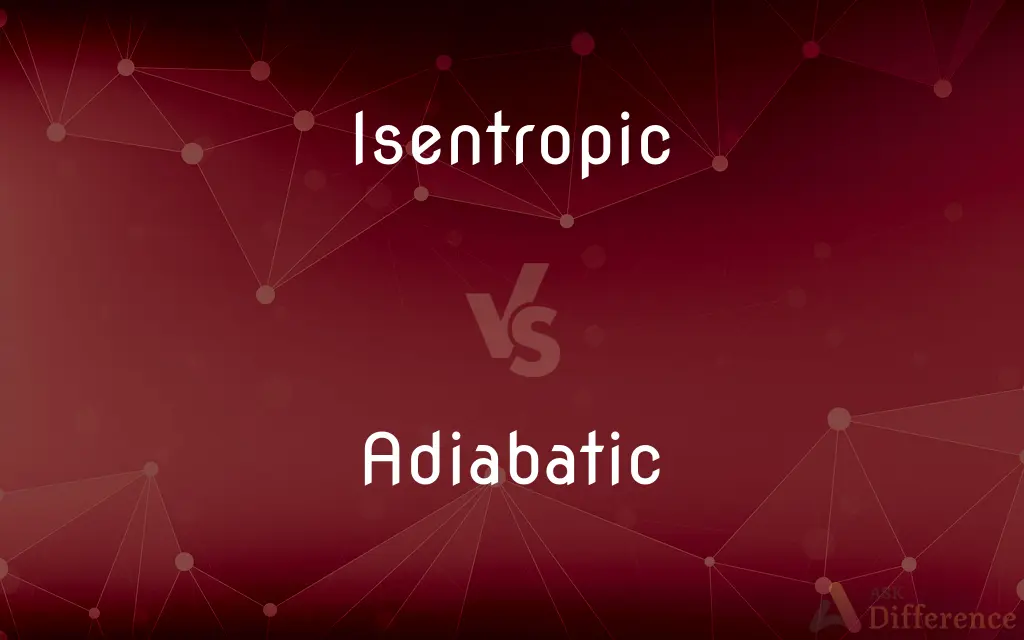Isentropic vs. Adiabatic — What's the Difference?
By Tayyaba Rehman — Published on October 18, 2023
Isentropic processes are reversible and entail no change in entropy; Adiabatic processes involve no heat transfer. Both terms describe thermodynamic processes.

Difference Between Isentropic and Adiabatic
Table of Contents
ADVERTISEMENT
Key Differences
Isentropic processes stand out in the realm of thermodynamics because they don't result in a change in entropy. This means that, for the entire duration of an Isentropic process, entropy remains constant. On the contrary, Adiabatic processes are characterized by the absence of heat transfer into or out of a system. Simply put, they happen in isolation from any external heat source or sink.
Diving into practical examples, when we compress or expand a gas quickly, it's likely an Adiabatic process because there's insufficient time for heat to be exchanged with the surroundings. On the other hand, if the same gas expansion or compression is done reversibly and results in constant entropy, it can be described as Isentropic.
When considering real-world applications, engineers often assume processes to be Isentropic in turbines, compressors, and nozzles when they aim to achieve maximal efficiency. Adiabatic assumptions, meanwhile, are common in scenarios where rapid events occur, and heat exchange is minimal or negligible.
It's essential to note that while all Isentropic processes are Adiabatic, the inverse isn't necessarily true. An Adiabatic process can lead to changes in entropy, but an Isentropic one will never deviate from its constant entropy state.
Finally, these terms are paramount in fields like thermodynamics and fluid dynamics. Isentropic flows, for instance, are crucial in the study of supersonic flight, while Adiabatic processes are foundational in understanding phenomena like the lapse rate in meteorology.
ADVERTISEMENT
Comparison Chart
Definition
No change in entropy
No heat transfer
Always Reversible?
Yes
No
Entropy Change
Zero
Can vary
Common Assumption In
Turbines, compressors, nozzles
Rapid gas expansion/compression
Heat Transfer
None (because entropy is constant)
None (by definition)
Compare with Definitions
Isentropic
A thermodynamic process with constant entropy.
The expansion in an ideal turbine is considered Isentropic.
Adiabatic
Thermodynamic process in isolated systems.
The Adiabatic flame temperature determines maximum temperature without heat loss.
Isentropic
Describes equilibrium processes without entropy variation.
The Isentropic efficiency of a compressor gauges its performance.
Adiabatic
No exchange of heat with surroundings.
Adiabatic walls ensure no heat flow in or out.
Isentropic
Pertains to conditions without entropy change.
Engineers often aim for Isentropic flow in nozzles for efficiency.
Adiabatic
Can be reversible or irreversible.
A quick compression of air can be an Adiabatic process.
Isentropic
Always reversible in nature.
In real-world applications, few processes are perfectly Isentropic.
Adiabatic
Heat remains constant within the system.
Adiabatic cooling results from expanding air without heat addition.
Isentropic
Constant entropy throughout the process.
An Isentropic compression is ideal but hard to achieve in reality.
Adiabatic
A process without heat transfer.
Rapid gas expansion is usually considered Adiabatic.
Isentropic
Without change in entropy; at constant entropy.
Adiabatic
Of, relating to, or being a reversible thermodynamic process that occurs without gain or loss of heat and without a change in entropy.
Isentropic
Having a constant entropy
Adiabatic
That occurs without gain or loss of heat (and thus with no change in entropy, in the quasistatic approximation).
Isentropic
Having equal entropy.
Adiabatic
That involves the slow change of the Hamiltonian of a system from its initial value to a final value.
Isentropic
With unchanging entropy; at constant entropy
Adiabatic
An adiabatic curve or graph
Adiabatic
Not giving out or receiving heat.
Adiabatic
Occurring without loss or gain of heat;
Adiabatic expansion
Common Curiosities
How is Adiabatic different from Isentropic?
Adiabatic means no heat transfer, while Isentropic means constant entropy.
What does Isentropic mean?
Isentropic refers to processes with no change in entropy, typically reversible in nature.
Can an Adiabatic process change entropy?
Yes, while Isentropic processes have constant entropy, Adiabatic processes can change entropy.
Are all Isentropic processes also Adiabatic?
Yes, since Isentropic implies no entropy change and thus no heat transfer.
Why are Isentropic assumptions used in turbines?
It's an ideal scenario aiming for maximum efficiency in turbines.
What's an example of an Adiabatic process in daily life?
A good example is the rapid compression of a bicycle pump.
Can an Adiabatic process be irreversible?
Yes, Adiabatic processes can be both reversible and irreversible.
What drives the change in an Isentropic process if not heat or entropy?
Work interactions usually drive the change, especially in idealized Isentropic processes.
What fields utilize the concept of Adiabatic processes?
Meteorology, thermodynamics, and various engineering fields often use the Adiabatic concept.
Does Adiabatic mean no energy transfer?
No, it means no heat transfer. Work can still be transferred in Adiabatic processes.
How is Isentropic efficiency used?
It's a measure comparing the performance of real devices to an idealized Isentropic counterpart.
Is it common for real-world processes to be perfectly Isentropic?
No, it's an ideal condition; real-world processes often have some inefficiencies.
Is it possible for an Adiabatic process to have a change in temperature?
Yes, since temperature can change even if there's no heat transfer.
Can an Adiabatic process have constant entropy?
Yes, when an Adiabatic process is also Isentropic, its entropy remains constant.
Are Adiabatic walls realistic?
Perfectly Adiabatic walls are theoretical, but insulation can make walls nearly Adiabatic.
Share Your Discovery

Previous Comparison
Brand Name vs. Company Name
Next Comparison
Provident Fund vs. Pension FundAuthor Spotlight
Written by
Tayyaba RehmanTayyaba Rehman is a distinguished writer, currently serving as a primary contributor to askdifference.com. As a researcher in semantics and etymology, Tayyaba's passion for the complexity of languages and their distinctions has found a perfect home on the platform. Tayyaba delves into the intricacies of language, distinguishing between commonly confused words and phrases, thereby providing clarity for readers worldwide.
















































